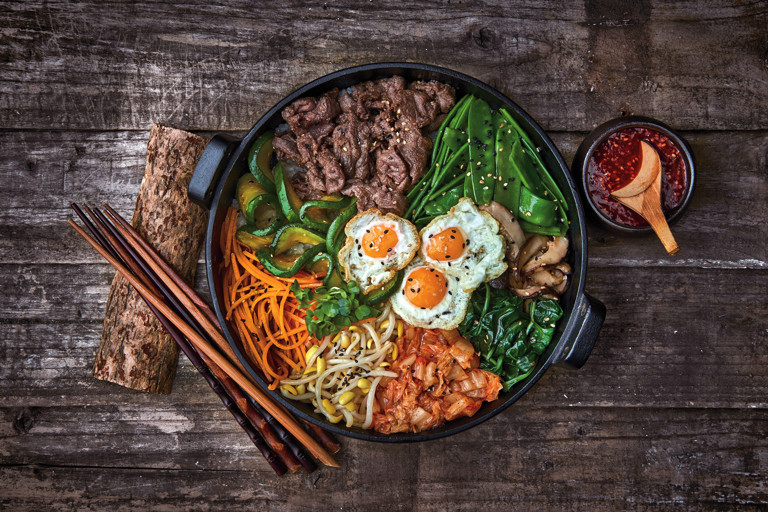Bibimbap – mixed rice bowl with beef
Judy Joo's easy bibimbap recipe is a simplified version of a Korean classic, with a colourful array of vegetables, meat and eggs sitting atop a mound of crisp fried rice. Arranging the vegetables in separate spokes makes this dish a wonderful centrepiece, although remember to mix everything together before you tuck in!
Bibimbap is one of my favourite dishes because I love eating vegetables. It's also very healthy. I always think that two-thirds of your plate should be covered with veggies. The variety of vegetables doesn't matter too much – use whatever you have. Chopped lettuce leaves or cucumber add a nice crunch, too. The cooking of this dish goes very quickly, so be sure you have all the ingredients before you start. (It might seem silly to cook the vegetables separately, but it makes a big difference in the finished dish.) I've simplified this version slightly by making one seasoning mix for all the vegetables. Traditionally, each vegetable would be seasoned individually. It does better keep the integrity of the flavours, but it is tedious. I've compromised by cooking each one separately, but using the same seasoning. I also make one giant one to share – as that's easier too.
Recipe extracted from Korean Food Made Simple: Easy and Delicious Korean Recipes to Prepare at Home by Judy Joo (Jacqui Small, £22). Photography by Jean Cazals
Ingredients
Metric
Imperial
Beef bibimbap
- 115g of beef, very thinly sliced, preferably bulgogi meat or rib eye
- 875g of rice, steamed
- 100g of beansprouts, tails and soft pieces removed, rinsed and dried
- 55g of shiitake mushrooms, destemmed and cut into 5mm slices
- 1/2 courgette, thinly sliced on an angle
- 85g of mangetout
- 1 carrot, julienned
- 180g of baby spinach
- 115g of kimchi, drained and chopped
- 1 tbsp of mirin
- 1 tbsp of toasted sesame oil
- vegetable oil, for frying
Seasoning
- 1 tbsp of toasted sesame oil
- 3 tbsp of soy sauce
- 2 tbsp of mirin
- 2 garlic cloves, finely chopped or grated
- 1 tsp fresh ginger, grated
- 1 tsp toasted sesame seeds, crushed
Gochujang sauce
- 3 tbsp of gochujang
- 2 1/2 tbsp of mirin
- 2 tsp sugar
- 2 tsp toasted sesame seeds
- 1 tsp toasted sesame oil
- 1 tsp spring onions, finely chopped on an angle
To serve
- 3 eggs, large
- black sesame seeds
Method
Get in touch
Please sign in or register to send a comment to Great British Chefs.



